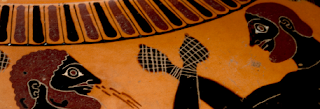Last week the Institute of Historical Research announced the
programme for their 81st Anglo-American Conference of Historians. This year the topic is on Ancients and Moderns. What do they mean by this? Well the primary question for the conference
is how does the classical world resonate in our own times? In line with that question is how successive
‘epochs’ since the Renaissance have pictured themselves in relation to ancient civilizations?
 |
| Logo for the 81s Anglo-American Conference of Historians hosted by the Institute of Historical Research |
There are many ways to answer and look at those questions
one of which is to turn to the revision of history produced in the sixteenth
century. This is exactly what I plan to
do in my paper for the Anglo-American conference. The paper entitled Ancient and Early Modern Martyrs: A Reformation
reappraisal of Britain’s Roman heritage as told by John Foxe will
look primarily at the history of the Roman period in the Acts and Monuments
and what this tells us about Foxe’s view of his own times.
The entire first book of the Acts and Monuments
was dedicated to early Christian and Roman history with Eusebius’ account of
early martyrs utilized by Foxe as a parallel to Protestants martyred under
Queen Mary. Eusebius of Caesarea (c. AD
263 – 339) wrote the first ever ecclesiastical history in the fourth century
and Foxe located his work in the same tradition. In this, Foxe was the first in England to
follow Eusebius’ lead since the Venerable Bede but he was not the only one to
do so in Christendom in the late sixteenth-century. A German reformer named Matthias Flacius was
also heavily involved in a collaborative project based in the city state of
Magdeburg. This project, basing itself
upon Eusebius’ church history, resulted in fourteen volumes charting Christian
history from the birth of Christ right through to the thirteenth century. It was to prove a valuable inspiration and
source for Foxe’s English-centric project.
 |
| Eusebius of Caesarea (AD 263-339) |
The return to Eusebius by protestant
reformers both in terms of content and in form had specific resonances for a
revised history of Christianity, especially one based upon the idea of the true
faithful as a persecuted people as Foxe’s was.
Thus far there have only been a handful of studies on the Eusebius
question and the Roman period in Foxe’s Acts and Monuments and
only two published:
- Minton,
Gretchen E., '"The Same Cause and Like Quarell" : Eusebius, John
Foxe, and the Evolution of Ecclesiastical History', Church History,
71:4 (2002), 715-42 .
- Freeman,
Thomas S., Great Searching out of Bookes and Autors: John Foxe as an
Ecclesiastical Historian, unpublished Ph.D (New Brunswick, The State
University of New Jersey, 1995).
- Pucci,
Michael S., ‘Reforming Roman Emperors: John Foxe’s characterisation of Constantine
in the Acts and Monuments’, in David Loades (ed.), John Foxe: An Historical Perspective (Aldershot, 1999), pp. 29-51.
The John Foxe project offers some additional
research in its commentaries although these are preliminary in nature and, I
should confess, were partly written by myself, and therefore represent my own
limited investigations into this area thus far.
Included amongst these commentaries is the fact that Foxe, like all
humanist scholars of his age, followed Cicero’s leges historiae –
i.e. that the first priority was truth.
Foxe uses Cicero’s ‘laws’ not only to justify his own text but to
derogatorily claim medieval chroniclers as having failed to attain the
aspiration of Cicero (see commentary for 1583, bk. 1, p. 24). Another commentary remarks upon Foxe’s
overriding prophetic framework based loosely upon that of John Bale’s Image of Bothe Churches
(1545). Foxe structured his account of
early martyrs via Eusebius but also through the lens of ‘two kingdom’ theory
(the idea that there were a distinction between the affairs of this world and
the kingdom of Christ) and the second of the visible and invisible church (see
commentary for 1583, bk. 1, p. 53). For
the account of the ten persecutions we know that Foxe relied heavily upon the
German ecclesiastical history, the commonly named Magdeburg Centuries that I
mentioned earlier, and a handful of other sources including, presumably, a copy
of Eusebius’ ecclesiastical history.
However, as discussed in the commentary for 1583, bk. 1, p. 57
investigations into this portion of Foxe’s book remains at a preliminary
stage. It is therefore these ten
persecutions that I will be most interested in looking at for my paper.
No comments:
Post a Comment